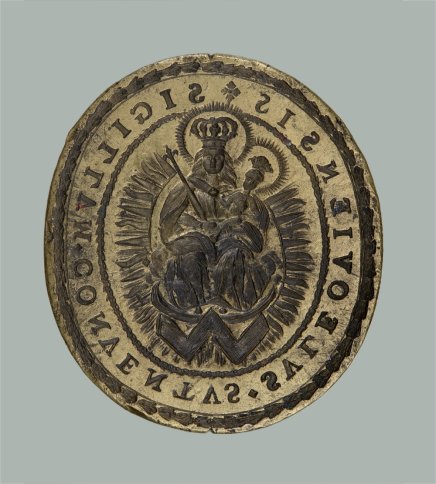Seals and seal matrices
06.09.2022-26.02.2023
Seals and seal matrices are two closely related concepts; the former is a sign (either graphic or in the form of an inscription) representing an individual or institution and indicating individual property, while a seal matrix is the object with which this sign is created and repeated. We commonly call a seal any kind of stamped or embossed sign, regardless of the material it is made of.
The seal matrix, that is the die used to create the seal, was made of durable materials such as stone or metal, and the seal resulting from using this matrix was made of a malleable material which hardened relatively quickly.
Documents written on parchment were frequently supplied with a seal embossed in wax and more rarely, as in the case of bullae, a form of inscribed token, metals such as lead or gold were used. Dies for wax seals were most often stored in a specially formed bowl of raw wax or in lathe-worked wooden boxes closed with decorative lids. Seals were also suspended from a document on strips of parchment or braided strings, for example made of dyed silk threads which were encased in layers of the malleable material. Seals are known, in particular ones belonging to monarchs, which consisted of two parts; just like a coin, they had an obverse and a reverse of the same dimensions.
The oldest seal which has been discovered and copied belonging to the rulers of the Polish Piast dynasty is the seal of Queen Rycheza (d. 1063), who from 1013 was the wife of Mieszko II Lambert, while the next oldest belonged to her grandson, Władysław Herman (1043-1102), the son of Kazimierz I the Restorer. The presentation of impressions of the seals of Polish kings begins with the seal of Przemysł II (crowned 1295) and ends with examples of seal impressions and a still extant seal matrix which belonged to King Stanisław II August.
Many seals of kings, state and church authorities, and rank-and-file representatives of the noble class and bourgeoisie have survived on paper documents from the 16th-19th centuries. They were embossed into a flour and water mass called sealing wafer, sometimes with the addition of a small amount of wax, placed between two layers of paper – the document itself and a smaller piece of paper appropriate for the size of the seal matrix. Starting in the 16th century, use was made of sealing wax, a mixture of resins, turpentine, and oil, softened by heating and which quickly cooled and hardened. Seal matrices engraved as a negative image or inscription could also be used to create ink seals, or rather soot seals (as they were blackened with soot by holding them over a candle and the resulting soot left an image just like ink), resulting in white graphic elements and inscriptions over a black background. From the 18th century, dry seals became more common, embossed directly into the paper without the use of an additional material, and using the same type of die as was used for wax or wafer seals.
The collection of metal seal impressions was created thanks to the activity of Franciszek Piekosiński, (1844-1906), a professor at Jagiellonian University, historian of the Middle Ages, and director of the Kraków archive, who arranged for more than 700 seals, mainly medieval, to be made. The small paper documents with wafer, wax, and dry seals including receipts, declarations and protocols come from the collection of Wiktor Windyk Wittyg (1857-1921), numismatist, sigillographer, and heraldist, assembled as material for historical research which ultimately resulted in the publication of his work on noble and bourgeois coats-of-arms in Poland.
Agnieszka Perzanowska
The Hutten-Czapski Museum
ul. Piłsudskiego 12, 31-109 Kraków- Monday: closed
- tue : 10.00-18.00
- wednesday-sunday: 10.00-16.00